All three hourly Elliott wave charts published yesterday expected at least some upwards movement. So far that is what has happened. Classic analysis will be used today to judge which of the three scenarios looks most likely.
Summary: Assume the trend remains down while price remains below 1,289.67.
A new high above 1,289.67 (the high for 2nd of October) by any amount at any time frame would indicate more upwards movement. At that stage, use the target at 1,330 – 1,334 in the first instance.
If upwards movement shows reasonable strength with support from volume, then it may go as high as 1,420, but that would require a new high above 1,357.09 for reasonable confidence.
Always trade with stops and invest only 1-5% of equity on any one trade.
New updates to this analysis are in bold.
Last monthly charts for the main wave count are here, another monthly alternate is here, and video is here.
Grand SuperCycle analysis is here.
The wave counts will be labelled first and second. Classic technical analysis will be used to determine which wave count looks to be more likely.
FIRST ELLIOTT WAVE COUNT
WEEKLY CHART
There are more than 23 possible corrective structures that B waves may take, and although cycle wave b still fits well at this stage as a triangle, it may still be another structure. This wave count looks at the possibility that it may be a double zigzag.
If cycle wave b is a double zigzag, then current upwards movement may be part of the second zigzag in the double, labelled primary wave Y.
The target remains the same.
Within intermediate wave (C), no second wave correction may move beyond the start of its first wave below 1,205.41. However, prior to invalidation, this wave count may be discarded if price breaks below the lower edge of the black Elliott channel. If this wave count is correct, then intermediate wave (C) should not break below the Elliott channel which contains the zigzag of primary wave Y upwards.
There are two problems with this wave count which reduce its probability in terms of Elliott wave:
1. Cycle wave b is a double zigzag, but primary wave X within the double is deep and time consuming. While this is possible, it is much more common for X waves within double zigzags to be brief and shallow.
2. Intermediate wave (B) within the zigzag of primary wave Y is a double flat correction. These are extremely rare, even rarer than running flats. The rarity of this structure must further reduce the probability of this wave count.
DAILY CHART
The analysis will focus on the structure of intermediate wave (C). To see details of all the bull movement for this year see daily charts here.
Intermediate wave (C) must be a five wave structure, either an impulse or an ending diagonal. It is unfolding as the more common impulse.
It is possible that minor wave 1 may have been over at the last high and the current pullback may be minor wave 2. Minor wave 2 may not move beyond the start of minor wave 1 below 1,205.41.
Minor wave 2 may not be over and may continue lower to reach a more normal depth of about 0.618 the length of minor wave 1, about 1,261. This would also see minor wave 2 have a better proportion to minor wave 1 in terms of duration; minor wave 1 lasted 44 days and so far minor wave 2 has lasted only 18 days. If it continues now for another 3 days, it may total a Fibonacci 21.
HOURLY CHART
BarChart have fixed the problem with their data for current data, but the problem of past data for the sessions from 28th September to 2nd of October is not fixed. As members can see, the data for the whole of minuette wave (b) is still wrong. This was probably some kind of combination; I will analyse that when the data is fixed. At this time, it will make no difference at all to the analysis because it is clear that minuette wave (b) is over no matter what structure it was.
I have checked the subdivisions within minuette wave (c) on PMBull data and this will subdivide neatly into a five wave structure at the hourly chart level.
If minuette wave (c) is not complete, then only subminuette waves i and now ii within it may be over. Subminuette wave ii may be a zigzag that may have ended very close to the 0.618 Fibonacci ratio of subminuette wave i.
However, to see subminuette wave ii as a completed three wave zigzag results in the subdivisions not having as neat a fit as when we see this upwards movement as a five wave structure. Either my labelling here of subminuette wave ii as complete is wrong and it may move higher, or either of the alternate below or the second hourly Elliott wave chart below is right.
This hourly wave count now expects another wave down with some increase in momentum for subminuette wave iii.
If the target for this hourly wave count is wrong, it may not be low enough.
If it continues further, then subminuette wave ii may not move beyond the start of subminuette wave i above 1,289.67.
Price remains so far within the best fit channel, copied over from the daily chart. While price remains within that channel, then no confidence in the idea of a low in place for Gold may be had.
ALTERNATE HOURLY CHART
It is possible to see that minor wave 2 could be over by simply moving the degree of labelling within minuette wave (c) all up one degree.
This wave count requires a new high above the high for the 2nd of October (which for BarChart data was at 1,289.67) before any confidence may be had in it.
The trend remains the same until proven otherwise. Assume the trend is down until price proves it is not.
If the next wave up is the start of a third wave at minor degree, then it should have support from volume. Upwards movement does have some support from volume today, but the weak candlestick is problematic for this wave count.
SECOND ELLIOTT WAVE COUNT
WEEKLY CHART
It is still possible that cycle wave b is unfolding as a regular contracting triangle.
Within a triangle, one sub-wave should be a more complicated multiple, which may be primary wave C. This is the most common sub-wave of the triangle to subdivide into a multiple.
Intermediate wave (Y) now looks like a complete zigzag at the weekly chart level.
Primary wave D of a contracting triangle may not move beyond the end of primary wave B below 1,123.08. Contracting triangles are the most common variety.
Primary wave D of a barrier triangle should end about the same level as primary wave B at 1,123.08, so that the B-D trend line remains essentially flat. This involves some subjectivity; price may move slightly below 1,123.08 and the triangle wave count may remain valid. This is the only Elliott wave rule which is not black and white.
Finally, primary wave E of a contracting or barrier triangle may not move beyond the end of primary wave C above 1,295.65. Primary wave E would most likely fall short of the A-C trend line. But if it does not end there, then it can slightly overshoot that trend line.
Primary wave A lasted 31 weeks, primary wave B lasted 23 weeks, and primary wave C lasted 38 weeks.
The A-C trend line now has too weak a slope. At this stage, this is now a problem for this wave count, the upper A-C trend line no longer has such a typical look.
Within primary wave D, no part of the zigzag may move beyond its start above 1,357.09.
DAILY CHART
This second wave count expects the new wave down may be deeper and longer lasting than the first wave count allows for.
A common length for triangle sub-waves is from 0.8 to 0.85 the length of the prior wave. Primary wave D would reach this range from 1,170 to 1,158.
If primary wave C is correctly labelled as a double zigzag, then primary wave D must be a single zigzag.
Within the single zigzag of primary wave D, intermediate wave (A) is labelled as an incomplete impulse.
Within intermediate wave (A), minor wave 1 will fit as a five wave impulse. While it is possible that minor wave 2 could have been over at the high for the 25th of September, it would be remarkably brief and shallow; the proportions between minor waves 1 and 2 would be very poor.
It is still more likely that minor wave 2 is continuing further as an expanded flat correction. Expanded flats are very common structures. The most common length for their B waves is from 1 to 1.38 times the length of their A waves. Here, minute wave b is now a 1.80 length to minute wave a. This is longer than the most common length but still within allowable limits of up to 2 times the length of minute wave a.
If price continues lower to 1,263 or below, then minute wave b would reach 2 times the length of minute wave a. At that stage, the idea of an expanded flat correction would be discarded based upon a very low probability.
The structure of minute wave b now looks to be complete at the hourly chart level. Here, on the daily chart, it looks like a three wave structure. So far this idea of an expanded flat currently unfolding still has a very good look.
HOURLY CHART
If price makes a new high above 1,289.67, then both the alternate hourly chart for the first wave count and this hourly chart for the second wave count will be possible. This wave count expects that upwards movement may be more brief: only minute wave c to end minor wave 2 of an expanded flat.
Expanded flats are very common structures. They can be identified as viable possibilities by looking for weakness within their B waves. Here, minute wave b shows a strong decline in volume and a decline in ATR. This offers some support to this wave count. However, there is no divergence with Stochastics at recent lows to indicate weakness, which is often a feature of B waves within expanded flats (often is not the same as always).
Because minute wave b is longer than 1.618 the length of minute wave a, the appropriate target for minute wave c is calculated using the 2.618 Fibonacci ratio. Minute wave c would be extremely likely to make at least a slight new high above the end of minute wave a at 1,292.62 to avoid a truncation and a very rare running flat correction.
Minor wave 2 may not move beyond the start of minor wave 1 above 1,357.09. This is the price point now which differentiates this second Elliott wave count from the first Elliott wave count.
Minute wave c must subdivide as a five wave structure. It would most likely be an impulse, but the less common ending diagonal should be considered if upwards movement is overlapping.
Upwards movement to the high labelled minuette wave (i) for this session will fit as a leading expanding diagonal. Second wave corrections following first wave leading diagonals are usually very deep. For this reason I would expect it to be most likely to see minuette wave (ii) move lower.
Minuette wave (ii) may not move beyond the start of minuette wave (i) below 1,268.42.
TECHNICAL ANALYSIS
WEEKLY CHART
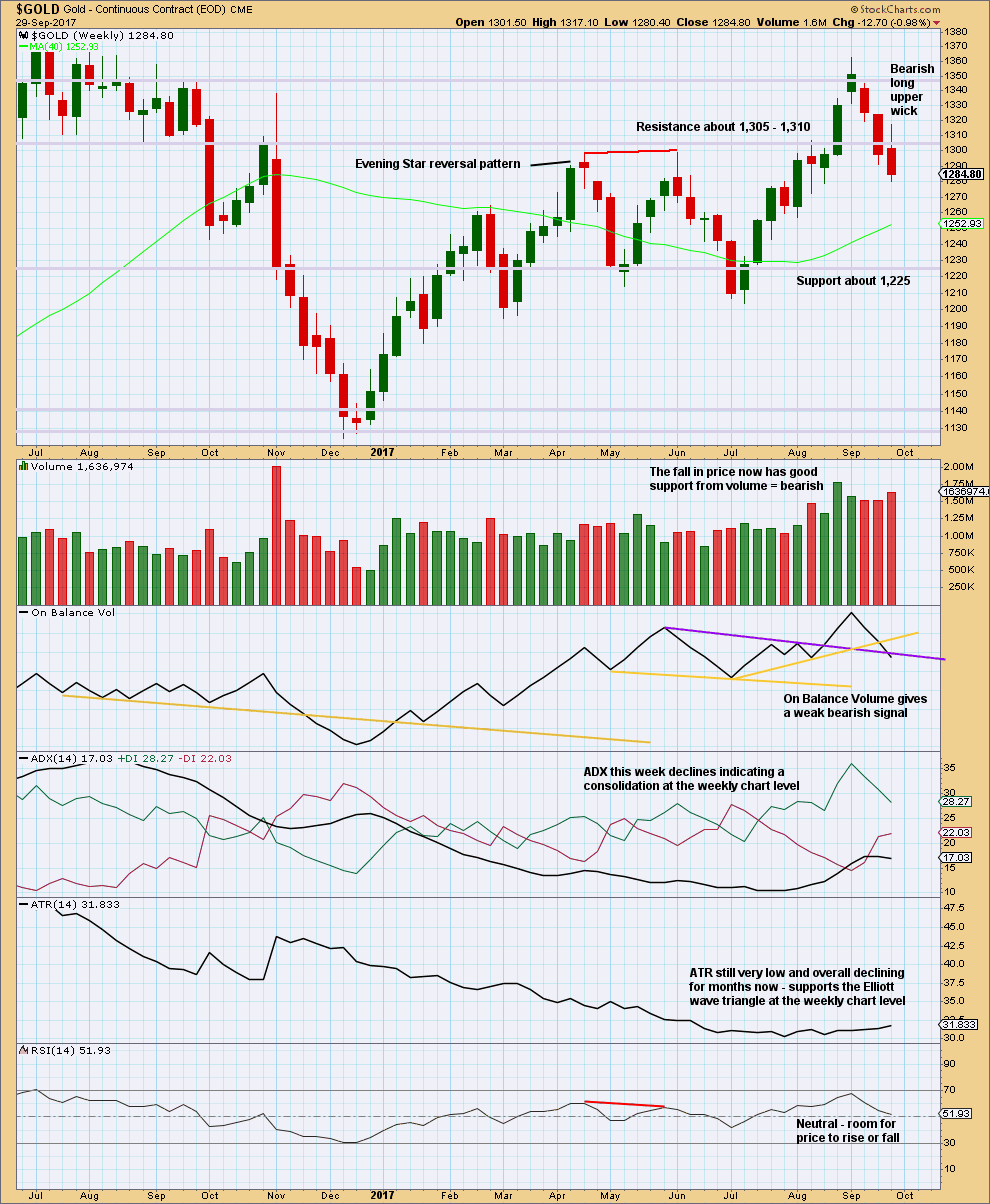
Click chart to enlarge. Chart courtesy of StockCharts.com.
Support of the Elliott wave counts which expect overall more downwards movement this week comes from an increase in volume last week for downwards movement, a bearish upper candlestick wick, and a weak bearish signal now from On Balance Volume.
These signals cannot tell us how far price may fall though. Support and resistance may be used as a guide for this. Next strong support for price is about 1,225.
DAILY CHART
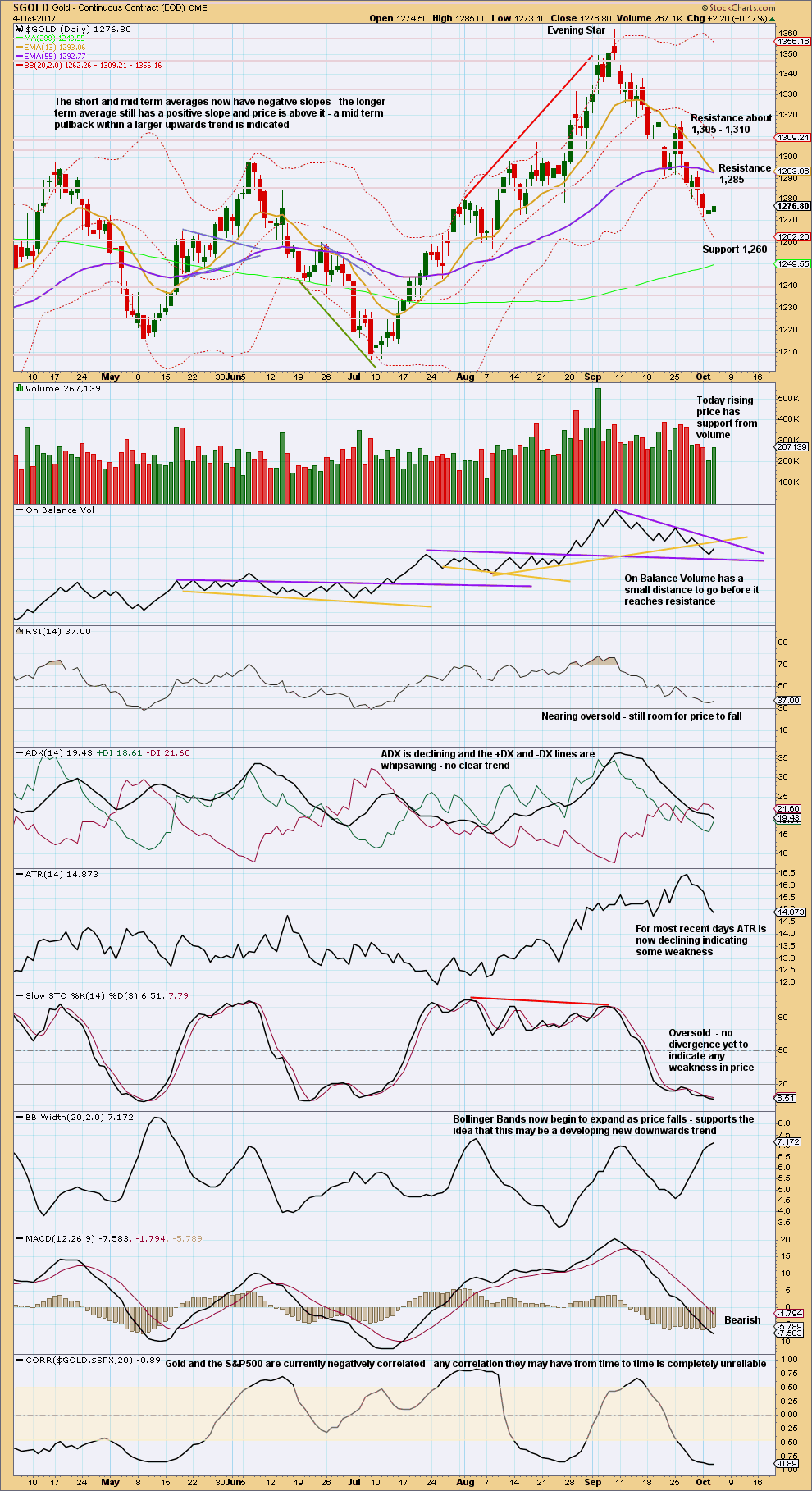
Click chart to enlarge. Chart courtesy of StockCharts.com.
Price has reacted from resistance about 1,285. The long upper wick on today’s candlestick is bearish. This supports the second Elliott wave count which sees a bounce within a downwards trend and not a trend change at the low.
Upwards movement has support today from volume, so more upwards movement for at least another day may be expected.
On Balance Volume may assist here to show when upwards movement may end at resistance.
The lack of divergence between price and Stochastics at the last low, and RSI not yet oversold, suggests that there is more downside still.
It is my judgement that this classic analysis best supports the second Elliott wave count today.
GDX
DAILY CHART
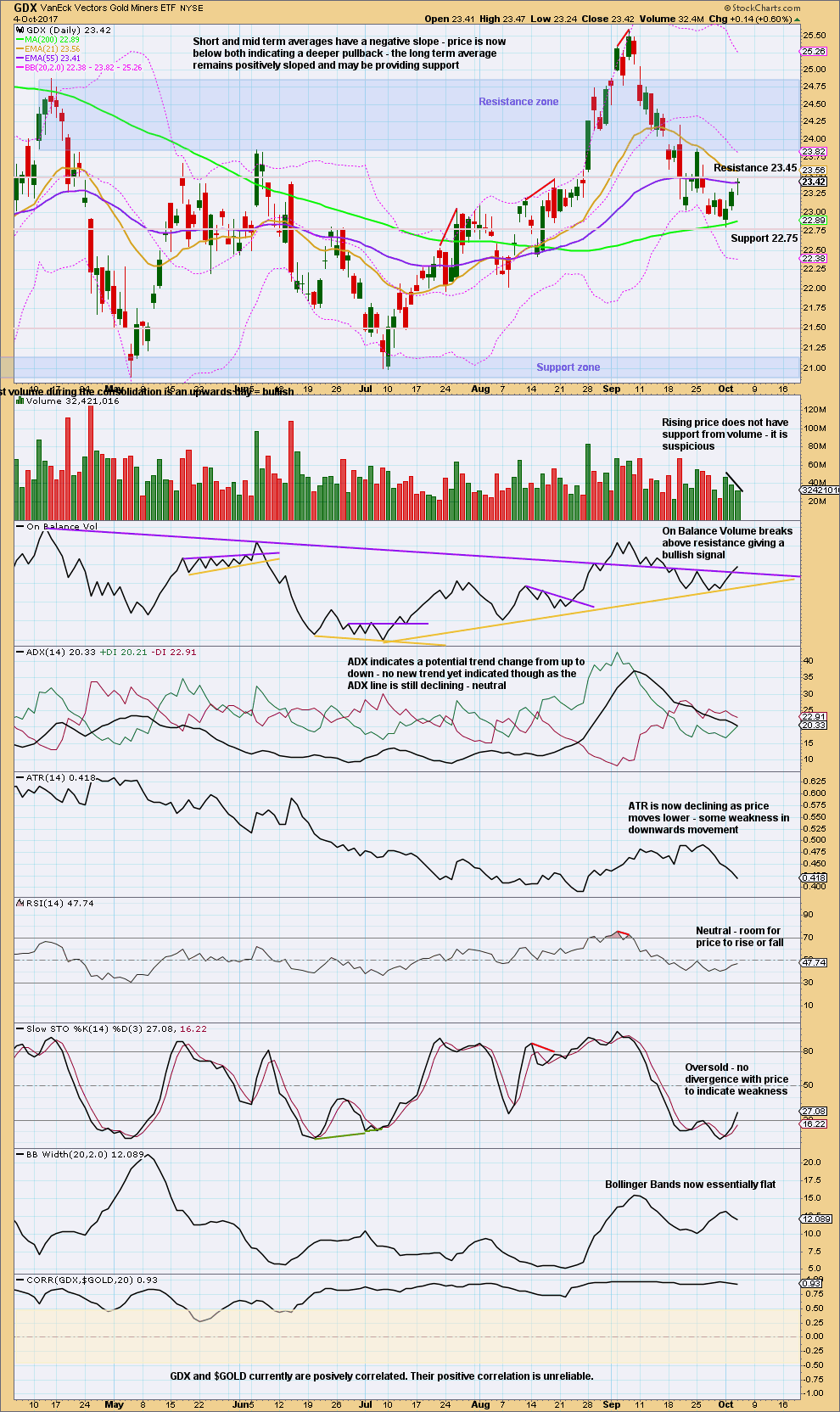
Click chart to enlarge. Chart courtesy of StockCharts.com.
Upwards movement for GDX at this stage looks very much like a small bounce within a larger downwards trend. If resistance at 23.45 gives way, then look for next resistance about 23.85. However, light volume with a small green doji today looks like the bounce may be done here.
The one strong note of caution to the above statement is a bullish signal today from On Balance Volume. The purple trend line was strong, but has recently been weakened with a move below it. Now it may rise further given that On Balance Volume is above this line again.
Like Gold, GDX did not exhibit any divergence with Stochastics at the last low nor did RSI reach oversold. There is room for price to move lower.
Published @ 10:17 p.m. EST.
[Note: Analysis is public today for promotional purposes. Specific trading advice and comments will remain private for members only.]

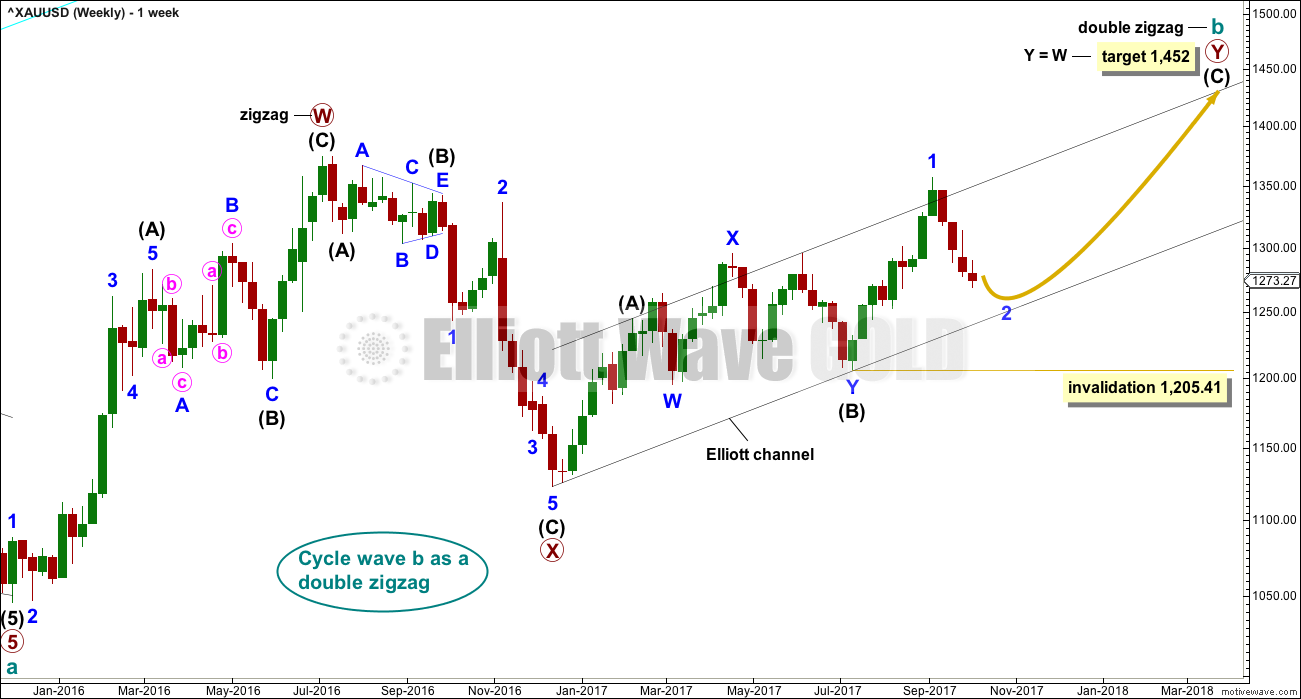
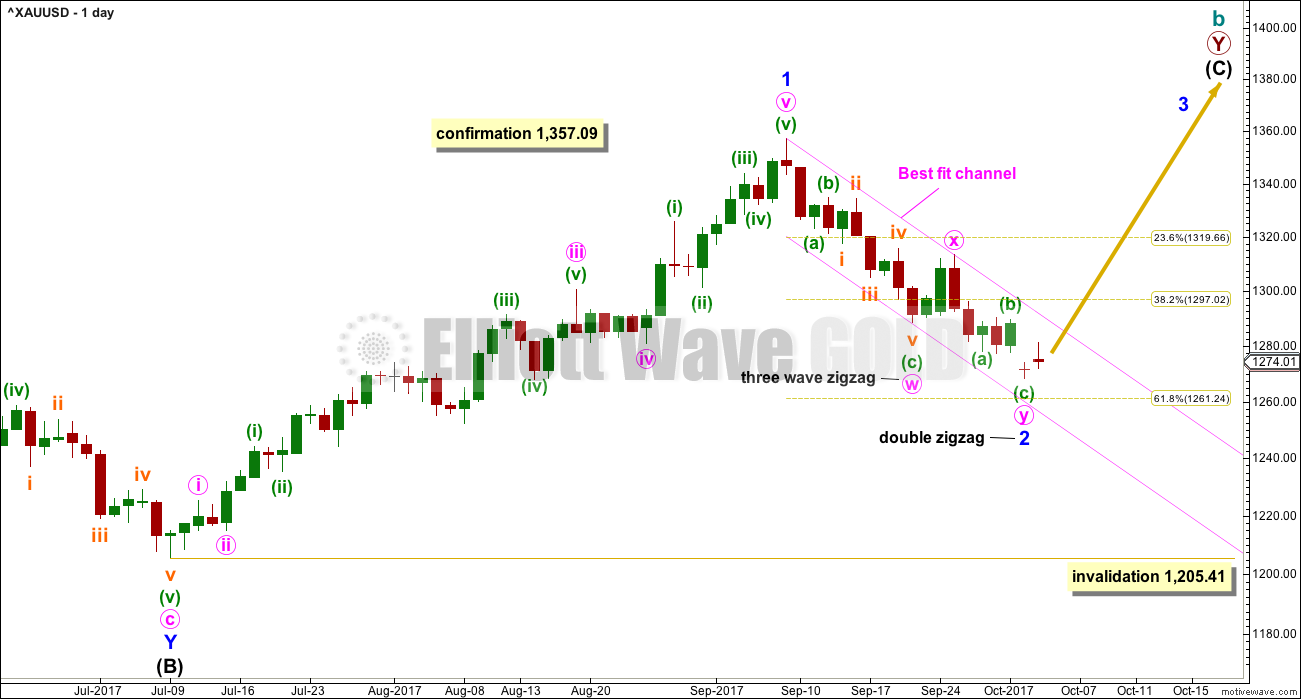
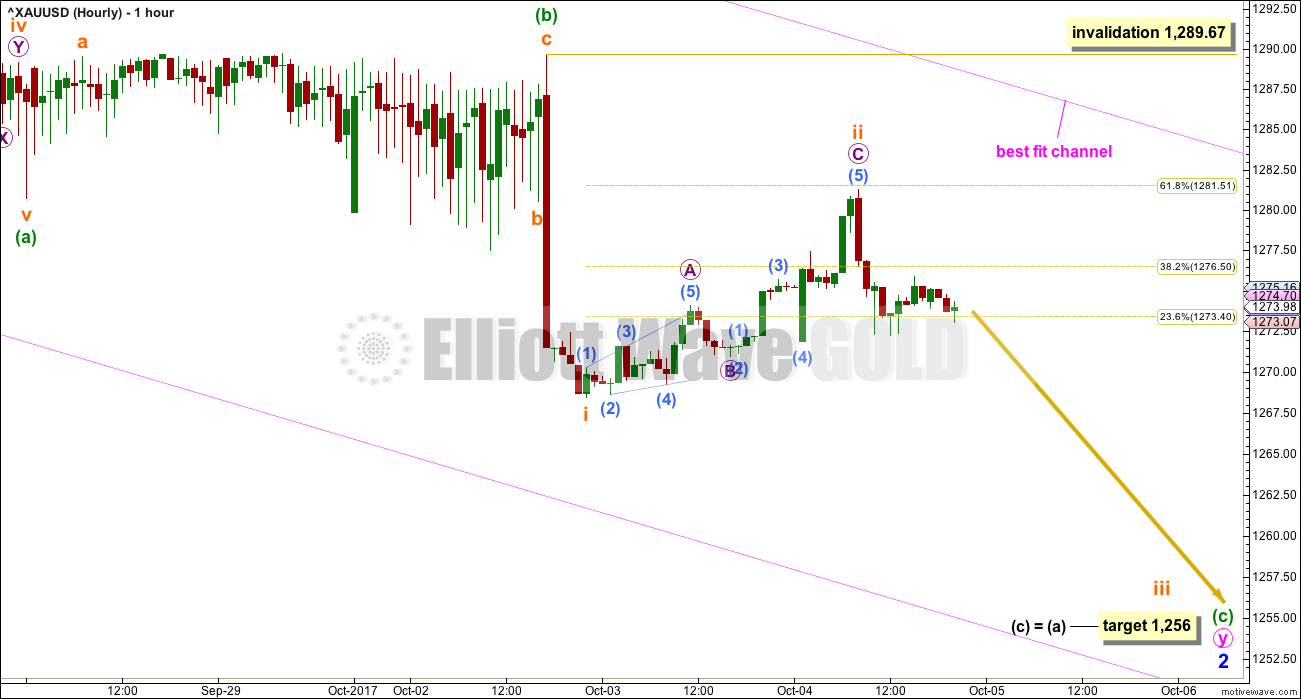
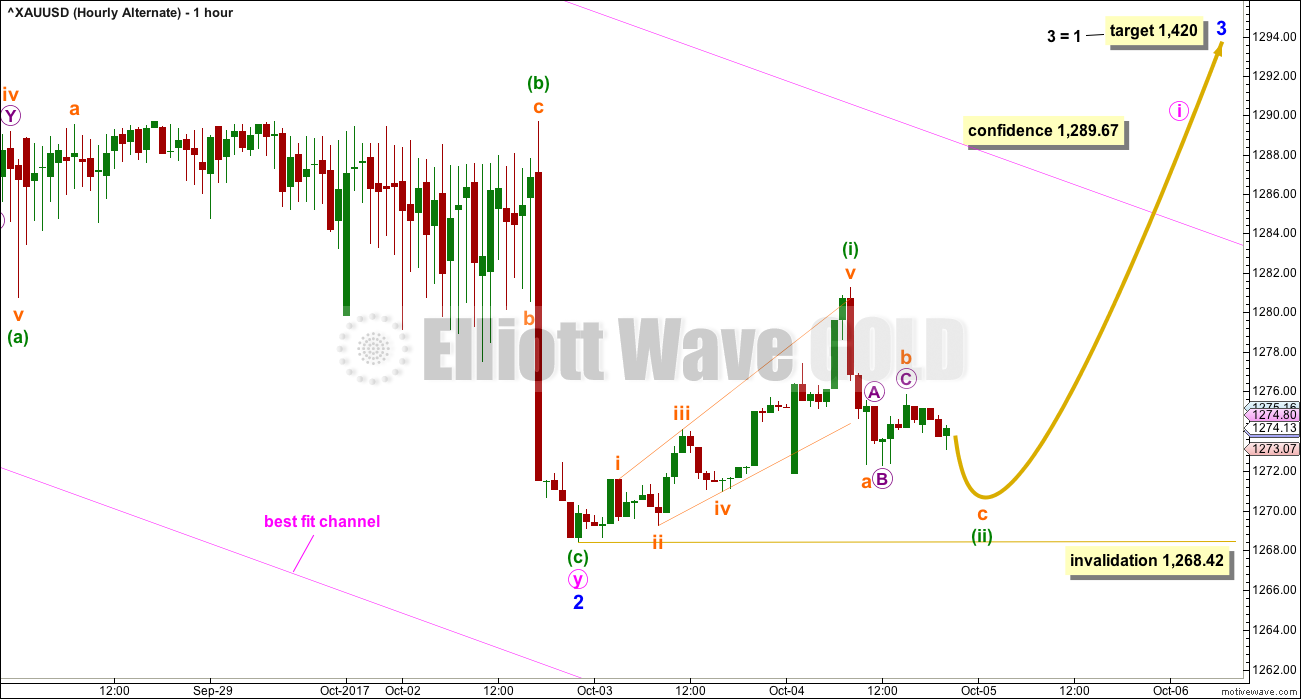
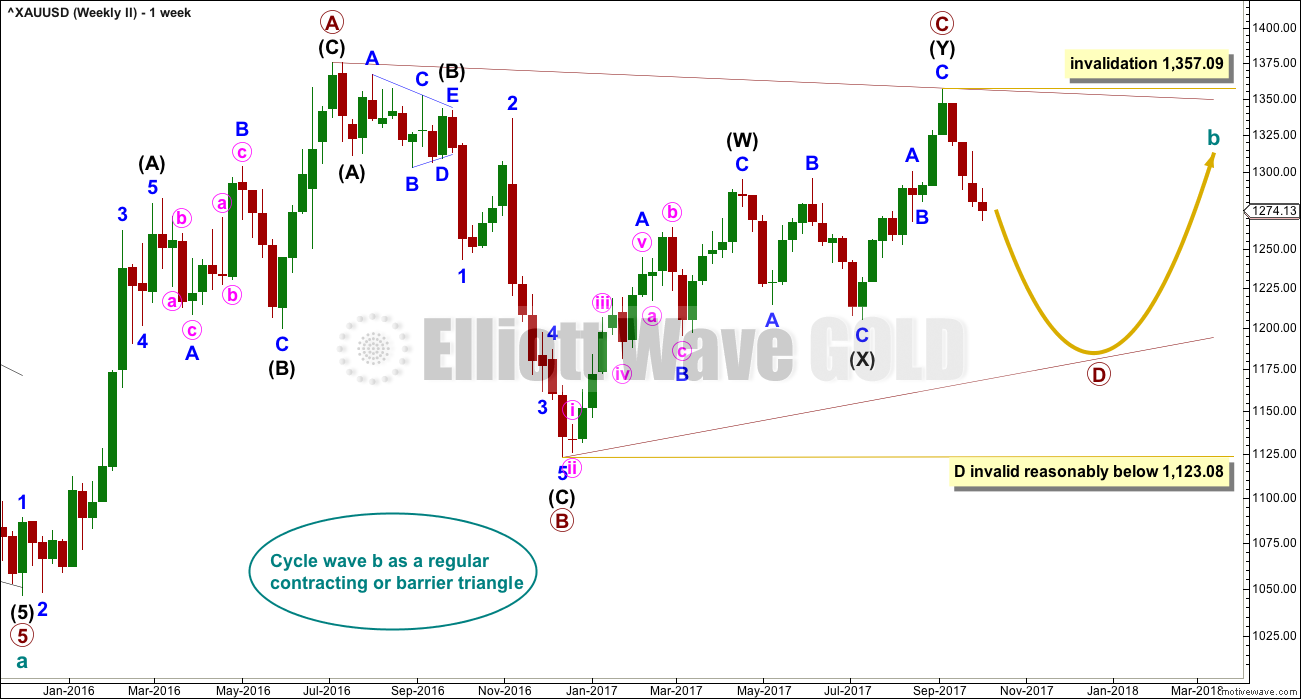
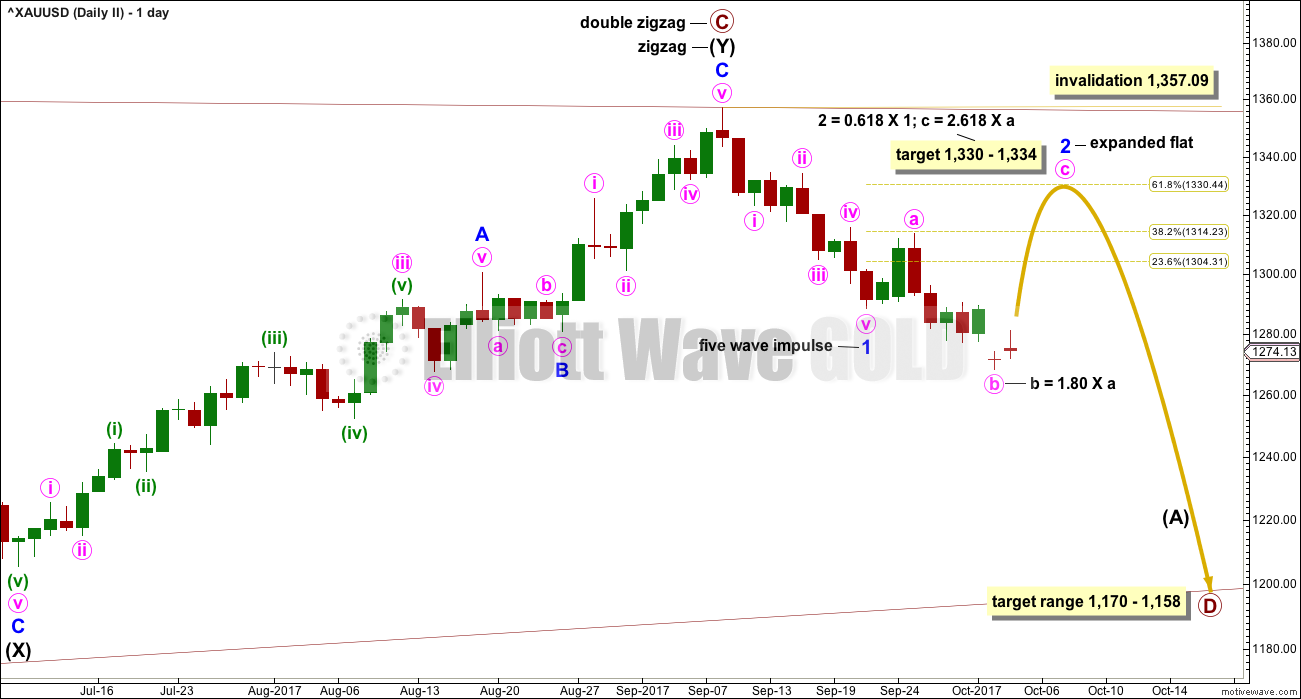

Short term trading: https://www.youtube.com/watch?v=1K1WBzWiMBo
Main hourly seems to be playing out. should turn near the 61.8% retracement.
Great stuff. As expected some upward movement followed by a drop. Both alternate hourly and second hourly invalidated. Lucky if Gold price can now make it back up to and past 1282. Staying short on the upturns seems to be the way to go.
The trend is down. Not expecting any upward movement to get past 1273 for 1277. A break below 1259 to play for.
This is my second week here and I am loving it. Just a brief introduction about me, since I am new. I live in Canada. I first came upon EWT (Elliott Wave Theory) from a short ebook “Five waves to Financial Freedom” by Ramki Ramakrishnan in 2009. That led me to EWI, Robert Prechter etc. A medical condition last year has forced me off work since last year (hopefully and with determination only temporary). Spending more time with EWT and came across Lara’s posting on youtube and got into this forum.
Lara’s meticulous and in-depth analysis is a valuable learning aid. I go through every analysis carefully, trying to understand the details and reasoning. Fabulous.
The forum members are also very knowledgeable and I am amazed at the collective EWT knowledge available here.
BTW, anybody here into RSI method as taught by Andrew Cardwell and Constance (Connie) Brown?
Now my question:
“Last monthly charts for the main wave count are here” takes you to analysis posted on August 28th, 2017. This has a MAIN ELLIOTT WAVE COUNT and an ALTERNATE ELLIOTT WAVE COUNT.
“another monthly alternate is here” takes you to analysis posted on June 7th, 2017. This also has a MAIN ELLIOTT WAVE COUNT and an ALTERNATE ELLIOTT WAVE COUNT.
Why two links, please? Should the main count be taken from the August 28th post and the alternate from the June 7th post?
Welcome David. As you are finding out, Lara is a great teacher and provides the most detailed EW analysis available. Good luck!
Thank you very much Dreamer. You are very good with EWT yourself and I appreciate your help as well. Thanks again.
Kindly ignore the question part of my comment, please. DD is the less favored option, barrier triangle being the more probable one, currently.
a contracting triangle I think, not a barrier triangle
the barrier triangle wouldn’t have trend lines that converge in a normal way because the A-C trend line doesn’t have a strong slope
Sorry Lara, I noticed my error after watching your video again. I was hoping that nobody would notice my error!! Thanks for catching it and correcting me, I sincerely appreciate it. Initially in my mind I had it confused that the A-C trend line lacking sufficient slope was what was making it a barrier triangle. After watching your video again, I looked up barrier triangles and differentiated barrier triangle in a bear market v/s that in a bull market. Thanks.
Hi David. Welcome aboard. We are from many different nationalities, yet you may notice we do have a rather warm camaraderie here. Some of us post quite often, intending to exchange viewpoints so that all of us can become better traders. We would dearly love to hear more from you.
Hi Alan. Thank you very much. I have tried a little bit of most everything. Tried Ichimoku cloud after Manesh Patel’s webinar in TC2000 a few years ago and I still use it as confirmation. Looking forward to learning from your analysis using the cloud. Very true, as you said there is definitely a camaraderie here, great. I have been able to devote more time to technical analysis only from last year and am probably an amateur compared with others in this forum. Thanks Alan.
Welcome David. Lara is the best EW analyst. She always sticks to the rules and guidelines provided in EWP book by Frost and Prechter 10th edition. If you intend to follow her analysis than it may be helpful you read up this book.
As for your question on why many chart of monthly, EW counts keeps changing due to price movement.
Only to use the latest link for monthly. All previous links and EW counts are invalidated and not the current count.
Since gold broke above Magee line the monthly and weekly chart changed from alternate to main count.
I hope that answers the question.
but then when it broke back down below the Magee trend line… I decided to not label them “main” and “alternate” and to sit on the fence with them
hence labelling them first and second
Thank you Papudi, much appreciated. I shall read up on EWT . Actually, I have to, if I am going to profit from this forum. Lara goes into such great depth and I have to watch the videos multiple times before the full import of her analysis sinks in. Thank you for answering my question and yes, I now have a clearer understanding after her latest video. The Magee line was broken but RSI monthly could not cross 60, which made it doubtful. Then price went back below confirming that the bear is still alive, for now. Regards.